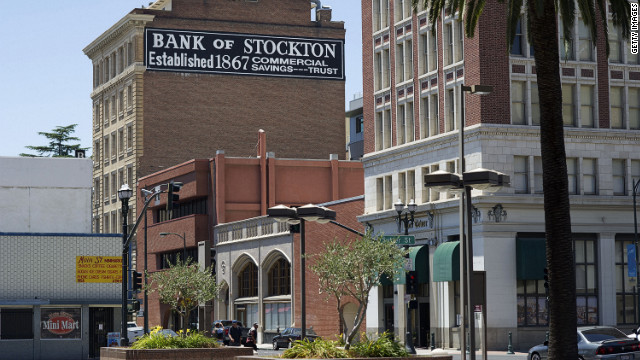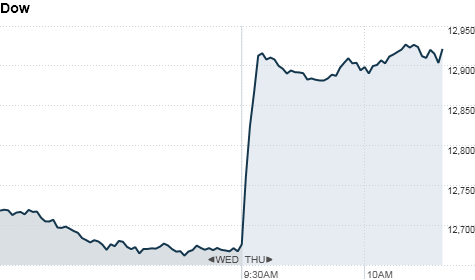NEW YORK (AP) – Major U.S. stock indexes started out slightly higher but reversed course as the lunch hour approached Monday. Investors are concerned as Treasury Secretary Timothy Geithner met in Europe with Germany's finance minister and the head of theEuropean Central Bank.
By Richard Drew, AP
Traders and specialists work on the floor of the New York Stock Exchange on July 17, 2012.
The Dow Jones industrial average and the broader Standard & Poor's 500 index were higher in late morning trading and then turned downward close to noon. The tech-laden Nasdaq composite index, which also had started out positive, reversed course and was slightly lower.
European Commission released a report Monday showing that economic sentiment dipped, with pessimism growing in both the industrial and service sectors. Also Monday, Spain's National Statistics Institute said its economy contracted for a third straight quarter.
STORY: Geithner heads to Germany for meetings on European debt
MORE: World Stocks
MORE: Today's most active stocks
Most of the attention Monday will continue to center on Europe, with Geithner meeting ECB's chair Draghi and Germany's finance minister to discuss the challenges facing Europe and the global economy.
The spotlight this week won't just be on Europe: Federal Reserve policymakers meet this week, and there are growing expectations that in light of waning economic growth, the Fed may announce a new monetary stimulus. The Bank of England also holds its monthly rate-setting meeting.
"With the rally we have had, the potential is for the central bankers to disappoint," said Louise Cooper, markets analyst at BGC Partners. "This Draghi-inspired rally may peter out if the central bankers fail to deliver."
Stock trend
Dow Jones industrial average, five trading days
Stocks, as well as the euro and the bond prices of Spain and Italy, had been buoyant since ECB president Draghi said last Thursday that the bank "is ready to do what it takes to preserve the euro. Believe me, it will be enough."
In the euro zone

Countries that use the euro currency: Austria, Belgium, Cyprus, Estonia, Finland, France, Germany, Greece, Ireland, Italy, Luxembourg, Malta, Netherlands, Portugal, Slovakia, Slovenia, Spain
Those comments raised expectations that, at the very least, the ECB will ramp up its bond-buying program in the hope of keeping a lid on Spanish and Italian borrowing rates. The recent sharp rise in Spain's interest rates raised concerns that the 17-country eurozone hasn't the capacity to bail out its fourth-largest economy, and raised the specter of Italy needing financial help, too.
Making sure that Spain and Italy can continue tapping financial markets for cash appears to be the priority of policymakers despite a warning from Germany's central bank, the Bundesbank, that the line between monetary and fiscal policy should not be blurred.
Both Spain and Italy have seen their borrowing rates in bond markets ease since Draghi's comments.
The yield on Spain's 10-year bonds has dropped significantly below the dangerous 7% level to around 6.60%, while Italy was able to raise a bigger than expected €5.5 billion ($6.77 billion) in a round of auctions Monday. Crucially, the yield on the 10-year bond fell to 5.96% from 6.19% the last time it was offered, a signal of improving investor appetite.
"There is no doubt that policy action is required given the escalation in the crisis and we think it unlikely that Draghi would endanger his reputation and credibility by not fulfilling expectations," said Neil MacKinnon, chief global strategist at VTB Capital.
In Europe, Germany's DAX rose 0.8% to 6,743 while the CAC-40 in France was 0.6% higher at 3,299. The FTSE 100 index of leading British shares was up 0.9% at 5,677.
The euro was down 0.5% to $1.2252 after figures from the European Union showed economic confidence in the eurozone fell to a 34-month low in July. News that the Spanish economy contracted a further 0.4% in the second quarter of the year, its third straight quarterly decline, also weighed it down.
Earlier in Asia, Japan's Nikkei 225 stock average closed up 0.8% at 8,635.44 and Hong Kong's Hang Seng jumped 1.6% to 19,585.40. Australia's S&P/ASX 200 climbed 0.9% to 4,245.70 and South Korea's Kospi rose 0.8% to 1,843.79. China's Shanghai Composite fell 0.9% to 2,109.91.
In energy trading, benchmark crude for September delivery was down 30 cents at $89.83 a barrel in electronic trading on the New York Mercantile Exchange.




![[image]](http://si.wsj.net/public/resources/images/OB-TX848_GDP2_E_20120727085902.jpg)

